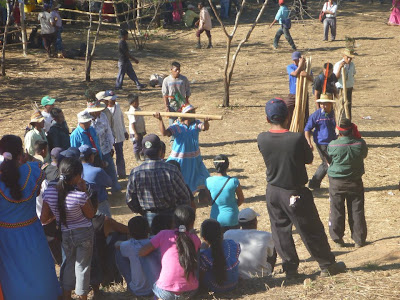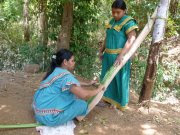At this point in my Peace Corps service most days are simultaneously incredible and rote. They pass noticed and noted in my journal yet they are unable to illuminate life as a volunteer in a tangible way for people in the back home in the United States. That being said, every so often I stumble upon a day, an hour, or single moment overflowing with poignant details that depict my PC experience precisely. It is times such as these that inspire and guide us through the formidable hardtimes. These experiences of clarity also excite a nascent blogger such as yours truly as it makes my life easy.
Quoting from my journal:
April 22, 2012
I ran barefoot for the third day in a row and my feet are sore so I stopped early then [visited] with Victor on my way home. He gave me two cocoanuts and a cup of coffee, then showed me around his land -he´s planted one thousand pineapples, five hundred yucca trees, and a bunch of sugarcane. He said he prefers to live here in the Comarca - "free" - and not in Cerro Punta (where he worked many years) even though he makes no money in the Comarca. He said this is because nobody can tell him what to do. As usual he asked me a lot of questions about the US. When I told him American´s get excited about the changing of the seasons just like Ngäbe´s do, he summed up that fact in one of these effortlessly elegant statements that I´ve grown accustomed to hearing from Ngäbe´s, especially him. He said, "well, we all have five fingers and we´re all human. Some of us just have a different race or speak differently, but we´re all human."
After showing me around he took me to his small cemetary which holds five people. I´ve never seen it before - I didn´t even know of its existence! There, his grandparents are buried beside one of his sons who died before his fifth birthday. Two of Samuel´s [Victor´s brother] children are buried there as well. A chilling moment to realize they have outlived some of their children, and that this seems to be semi-common.The next day I asked Samuel about his two children in the cemetary. One, he said, was a stillbirth roughly two years ago. But the other child Samuel loved very much. He kept repeating that he adored the child and shared a special bond with him. When the child developed a respitory ailment Samuel gave him a concoction of natural medicine that he learned to prepare from his grandmother. Confident the child would recover Samuel got ready to attend an agriculture seminar in a latino town many miles away. He would be there one week. When he grabbed his backpack he turned and stubbed his toe on a rock. Later, just before leaving he walked to say goodbye to the sick child and stubbed the same toe on the same rock. In a hurry and thinking nothing of the coincidence, he limped away to attend the seminar.
A week later while buying food on his return home, a concerned friend approached Samuel in the store and said, "Samuel, people are saying there was a problem at your house. A child died, but I don´t know which." Samuel left the food, hiked the two hours to his home, and found his wife grieving over their recently-buried child. She told Samuel that the child´s breathing slowed and slowed, and eventually stopped.
Eight years later, Samuel still harbors guilt. He says to me, "I should have known, I should have seen the signs when I stubbed my toe twice before I left. I wasn´t suppossed to leave."















